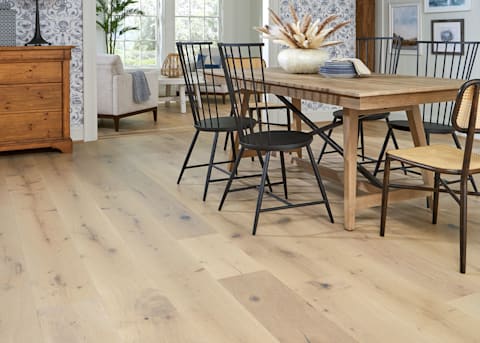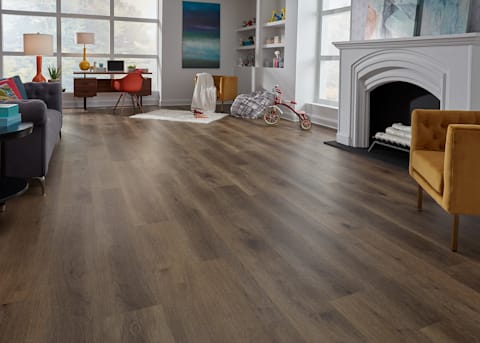- Home
- Education
- Flooring Basics
- Know Your Types of Wood Flooring: What Species Is the Best for Flooring?
Know Your Types of Wood Flooring: What Species Is the Best for Flooring?
Wondering what is the best wood species for flooring? Wonder no more with this handy guide from LL Flooring!
Hardwood floors come in a wide variety of species, including quality domestic options—which originate in North America—such as hickory and maple and beautiful exotic woods such as Brazilian cherry. But what are the differences between the various types of flooring wood? And what type of wood is the best for flooring?
We look at some of the different types of wood flooring to help you choose the right hardwood floor for your home.

Acacia
Acacia hardwood flooring has outstanding color from rich browns and auburn to pale bronze and beige. Its distinctive coloring can show up all in a single board, giving it a variegated appearance. Use acacia to warm up neutral spaces or add sophistication to your space. Short-leaf acacia is the more visually striking of the two primary types of acacia.
If you're looking at solid hardwood flooring, short-leaf acacia is also an exceptionally hard wood. On the other hand, solid hardwood long-leaf acacia is a softer wood, so be sure you know which type you're looking at. Both kinds of acacia allow for longer-lasting performance, but the short-leaf variety will stand up well to heavy foot traffic.
Bamboo
Bamboo is not actually a wood but is instead classified as grass. The kind of bamboo used in flooring is called moso bamboo and is generally grown in China. Bamboo is a great flooring choice that can come in a wide selection of rich colors, including sunny blondes, cinnamon browns, and grassy grays, and offers much of the same exquisite graining and detail as hardwood.
In addition to its good looks, bamboo offers excellent performance thanks to how hard it is. Because bamboo grows so quickly (approximately five years to maturity, compared to the 20 years and more hardwoods require), it's a more quickly replenished material than most trees.
Brazilian Cherry
The Brazilian cherry tree doesn't actually grow cherries—it's named for its rose-tinted wood boards, which intermix darker shades with brighter colors for additional appeal. Fine graining adds interest while remaining subtle enough to blend into the background.
Brazilian cherry is classified as an exotic species since it's typically grown outside North America. It's known for its toughness and excellent performance as flooring.
Hickory
Hickory is a widely distributed wood across North America. It can come in an array of colors, such as luscious blondes and cool ashes, with alternating intensities of hue providing distinctive variety and interest. Streaks of graining provide detail while letting the coloring take center stage.
Hickory is a tough, dense wood that combines strength and hardness to make an ideal wood for stable, stiff, and long-lasting flooring.
Maple
Maple used for hardwood flooring typically comes from the sugar maple, native to northeastern North America, and is also the tree that gives us maple syrup. Its bright blonde coloring adds warmth and vitality to any contemporary home, and while it looks great in its natural hue, it can also be easily stained for added vibrancy. Its graining can be subtle, rewarding close attention rather than flashy exuberance. Maple is a dense, hard wood that lasts.
Red Oak
Red oak is native to North America and is a widely popular hardwood flooring choice. Its natural color is a rose-tinted blonde but can be stained a darker shade depending on your home's design, with eye-catching, darker graining that stands out against the lighter wood.
Red oak is considered a medium-strength hardwood. In fact, it's used as the benchmark for determining whether a wood is "hard" or "soft", and will itself hold up against heavy foot traffic.
White Oak
White oak is another North American native species and looks great in homes of all styles. Its coloring blends honey tones with golden highlights, combined with subtle graining, but you could also choose to stain it any color you want. White oak boards create a more cohesive, connected look that creates a canvas for the rest of your home's décor without drawing attention to itself, such as hardwoods with greater color variation. You can also rest assured that white oak stands up well to foot traffic.
Imagine Your Home
Of course, no matter how much you read about the different species, there's nothing like picturing the wood in your own home. Try out LL Flooring's PictureIt! tool and see how different woods look in your home.
Follow LL Style on Instagram & Pinterest
ALSO, do you learn about home improvement and design with fun and informative videos? Subscribe to the LL Flooring YouTube Channel to learn more, leave comments or ideas that helped you, and join the community!


